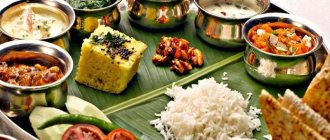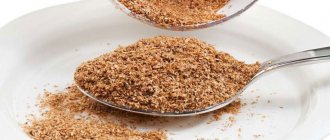Ayurveda - nutrition for weight loss and the ancient teaching of a healthy lifestyle - is not the easiest and fastest way to lose weight, but definitely one of the most effective and safe. The principle of this system is not in cruel deprivations and violence against the body, but in actions and rules accessible to everyone that will lead to a healthy lifestyle with a slim body and a strong spirit. To lose weight, you need to determine your types of doshas and balance them. Read more about this in the article: “Ayurveda, nutrition according to the doshas: food for fire, air and water”
And today we will talk about the general principles of Ayurveda, relevant for any dosha!
Ayurveda food that can adjust the internal balance of energies
Ayurveda believes that food can adjust the internal balance of energies, which will keep the body healthy. However, man has turned his back on nature and today perceives food as a means to satisfy desires. For some, food is a passion; for others, it is a way to relieve anxiety or escape from problems.
All the collected knowledge about how to eat is in Ayurvedic knowledge. This is a science that tells how to live in a physical body and how to properly consume food so that it is beneficial and not harmful.
Product Compatibility
Ayurveda has a whole section on food compatibility, it is very large. To understand exactly how to arrange your usual dishes, it is best to consult with a specialist.
However, there are general rules that indicate which combinations are unacceptable:
- meat or poultry dairy products;
- meat and dairy products;
- milk fruit;
- warm drinks (teas) honey;
- warm drinks (teas) yogurt (sour milk).
Proper nutrition in Ayurveda and body constitution
Ayurveda nutritional principles are based on three doshas, which are responsible for different processes related to physiology:
- vata – movement and breathing;
- pitta – digestion and metabolism;
- kapha – volume and structure.
Different doshas predominate in different bodies. The result is an individual constitution, which determines people’s habits, their preferences and dietary habits. As soon as a person breaks the rules, one or two doshas go out of balance, which leads to the formation of diseases. To maintain balance, you must adhere to certain nutritional rules that are formed for each individual dosha.
Losing weight depending on the doshas
To choose a weight loss method according to Ayurveda, a woman will need to determine the type of dosha:
- Vata women are easily excitable and active. Constant movement and changing circumstances allow you to stay slim. These are lovers of travel and relocation. They build relationships to fill the void. In food they prefer over-salted, sour, thick dishes. Sweet, hot, fatty foods will help balance your nature.
- Pitta-type people prefer to eat spicy, peppery foods. The digestive process goes smoothly. Such women should drink more juices and eat salads.
- Kapha-type women are characterized by calmness and inactivity. They are considered faithful wives and wonderful mothers. Such people love sweets, which leads to weight gain. For harmony, you should eat more hot and spicy foods: low-calorie cereals, ginger tea with lemon, vegetables with herbs.
Basic principles of Ayurvedic nutrition
Ayurveda considers nutrition in the finest details. It provides a person with detailed knowledge about under what circumstances one should eat in order to improve health. This science indicates the need to follow the rules for absolutely everyone without exception. The developed postulates must be observed regardless of the constitution of the body, habits and traditions that have developed in a particular country.
According to Ayurveda, food is absorbed by the body only when it is consumed correctly. Therefore, the benefits of foods depend not only on their vitamin content, but also on the conditions under which a person consumed this food. An important role is played by the mental and emotional state of a person during a meal.
The right time to eat according to Ayurveda
The principles of nutrition in Ayurveda play an important role. Time is one of them. A person cannot eat at the designated time. You need to eat when you are hungry. We should abandon the usual routine according to which we are used to eating in the morning, lunch and evening. You need to listen to your body and eat only when you are hungry. It is important to take into account that food is consumed 2-3 hours before bedtime. During sleep, food is not digested and it will spoil in the body until you wake up.
There is only one indicator for drinking water - thirst. If you drink water in excess, it will unbalance Pitta and Kapha, and also weaken the power of fire necessary for digestion. You should not drink water after a meal, as this slows down the process of food processing in the stomach. Other principles in Ayurveda nutrition are:
- to remove negative energy before eating, you need to wash your face, hands and feet;
- do not eat until the food from the previous meal has been digested;
- before eating you need to go to the toilet to empty your bowels or bladder;
- You should eat food only in a state of calm.
For different body constitutions, different types of fasting are proposed in Ayurveda. The process of consciously refusing food must be stopped when the digestive fire (Agni) is restored.
What not to do after eating
In Ayurveda, food should be calmly digested after consumption. Therefore, after eating it is necessary to arrive in a calm state and not engage in heavy physical labor. In order for the digestion process to proceed as best as possible for the body, after eating you should adhere to the following rules:
- refuse to take a shower, bath, sauna or other water procedures after eating;
- do not engage in hard mental work;
- get up abruptly from the table;
- do not lie on the sofa, as this will lead to excess weight formation.
After a meal, it is advisable to take a slow walk or start doing a calm, favorite activity.
Ayurveda for weight loss: nutritional rules for cleansing the intestines
Ayurveda nutrition for weight loss will require the following principles:
- you should eat slowly, in a calm atmosphere;
- after eating, rest is necessary;
- overeating should be avoided;
- You should start eating when hunger sets in;
- by the next meal, the process of digesting previously eaten dishes must be completed;
- It is prohibited to drink chilled drinks;
- You can eat only in a good mood.
If all recommendations are followed, women following an Ayurveda diet for weight loss will be able to not only lose excess weight, but also normalize metabolic processes, improve their well-being and normalize the functioning of the gastrointestinal tract.

What and how much can you eat according to Ayurveda?
What and how much you can eat according to Ayurveda is a simple question, but at the same time it requires clarification of some rules. According to Ayurveda, food should always be of high quality. It must be present in the house in sufficient quantities, clean and fresh. This can be a moist meal with butter that is light and tasty. But at the same time, it should be familiar to you and useful in its composition. You need to eat foods that complement each other well and can balance your entire diet.
How much food should you eat?
Ayurveda proper nutrition is, first of all, the presence of a sufficient amount of varied food. Eating small amounts of food and feeling constantly hungry weakens the body and leads to an imbalance of the doshas. However, undereating is less dangerous than overeating. After all, diseases caused by overeating are more difficult to treat than diseases caused by meager consumption of food.
The optimal amount of food is as much food as a person can fit in his two folded palms. After all, this is exactly the volume of the human stomach. The amount of water is drunk in the amount needed to quench thirst.
Don't overeat. The stomach should be half filled with solid food. The remaining part should be half filled with liquid, and the other should remain empty for normal air passage.
Products recommended in Ayurveda
Basic Ayurvedic food consists of grains. The main role is played by the following grains:
- rice;
- barley;
- wheat.
Millet, buckwheat and other similar products are considered less healthy among cereals.
After grains come legumes. With their help, a person replenishes protein reserves. They should be consumed with oil to avoid excess gas formation.
Milk is consumed immediately after the milking process, when it is still warm. Once it cools, it becomes heavy and forms mucus in the body. Milk should not be mixed with salt and consumed before bedtime. Fermented milk products should be consumed rarely, and baking made from them should be avoided.
An Ayurvedic diet should include ghee, which helps improve digestion and restore metabolism. Fruits are consumed before meals or as a separate meal. Vegetables should be combined with cereals. Honey is well absorbed when mixed with a glass of warm water.
What is not recommended to eat?
The Ayurvedic diet excludes meat, fish, seafood and eggs from the diet. Such food is difficult to digest. In addition, it carries the energy of death, which is filled with pain and fear. Mushrooms are considered a heavy food that takes a lot of energy to digest.
Tamasic foods that take energy also include hard cheese. It is recommended to completely exclude it from the diet, as it undergoes a process of rotting, which begins in the stomach after consumption.
What is allowed and prohibited in Ayurveda for weight loss?
Ayurveda pays a lot of attention to the origin of food. It is believed that good energy from regional products is absorbed by the body as much as possible, so give preference to local producers.
If you are serious about losing weight and getting healthier, Ayurveda recommends completely eliminating foods that contain preservatives and any chemicals from your diet. The exception is the cold season, when it is impossible to do without pickled vegetables.
Your diet should not contain any harmful foods or drinks; only natural, environmentally friendly food will help you achieve your goals. You should avoid the following products:
- sausage;
- semi-finished products;
- store-bought sauces;
- snacks;
- salted nuts;
- fast food;
- smoked meats;
- store-bought sweets;
- canned food;
- offal;
- soda, sweet store-bought juices;
- alcohol.
Ayurveda has a special attitude towards dairy products. It is believed that there is no need for an adult to consume milk; it is intended only for children. At different ages, our body reacts differently to certain components of the diet.
In Ayurveda, it is customary to minimally process foods so that they retain maximum nutrients. If you do not want to become a raw foodist, then simply refuse to prepare dishes by frying.
It is best to boil, bake, stew or steam food. As for vegetables, fruits and greens, they will bring maximum benefits to your body if they are fresh.

A unique cocktail for weight loss without dieting or harm to health!
You maintain your usual diet by replacing just one meal with this cocktail. A slim figure and a healthy body - that's what you get in the end!
Read more…
Fans of the system can consume the following products during the diet:
- vegetable soups;
- asparagus;
- legumes;
- homemade flour products;
- milk products at lunch or dinner.
Prohibitions are imposed on the following products:
- alcoholic drinks;
- seasonings;
- highly salted dishes;
- saffron;
- bananas for breakfast;
- fatty fish and meat dishes.
The Ayurveda diet cannot be used by women under certain circumstances. This is due to the fact that some dishes contain components that are prohibited under certain conditions:
- during pregnancy;
- when feeding the baby;
- for pathologies in the digestive organs;
- prescription of therapeutic dietary nutrition.
If one of the above circumstances is present, you should refuse to use the Ayurveda system. Otherwise, harm to the body is inevitable.
What else should you consider when creating an Ayurvedic menu?
The Ayurveda menu must take into account that food must be fresh and environmentally friendly. Food that has stood for more than 2-3 hours after cooking and has also partially deteriorated is not recommended for consumption. It is not recommended to heat food twice and eat it too hot.
To prevent food from being dry and contributing to stagnation in the intestines, you need to add vegetable oils to it. A lot of liquid food will lead to a weakening of the digestive fire.
The lighter the food, the better the body will absorb it. Food should be filled with pleasant tastes and smells. If a person eats food that does not bring him pleasure, then it will be harmful to him.
The Ayurvedic menu recommends giving preference to the food that a person has eaten since childhood and which is familiar to him. Rarely eaten foods that are not in season can cause poor digestion.
At one time, food should be rich in all tastes:
- sweet;
- salty;
- bitter;
- sour;
- spicy;
- astringent.
The combined combination of flavors has a beneficial effect on tissue cleansing, improves organ function and promotes mental function.
It is necessary to start your meal with heavier foods that have a sweet taste. Next come foods with a sour taste and you should finish your meal with light foods.
An Ayurvedic diet should include foods that are suitable for an individual based on his or her personal characteristics. In this case, it is necessary to take into account the current state of the body and the presence of diseases.
Foods that are harmful to eat together
In Ayurveda, food is considered harmful if it is not combined correctly. This phenomenon is called Viruddha. Foods that are incompatible with each other form mixtures with new qualities. Products may not be compatible due to various factors:
- guna;
- taste;
- energy;
- time;
- effect on the human body.
Milk and fermented milk products should not be eaten with vegetables and fruits.
It is harmful to eat cold and dry food in winter. Don’t get carried away by tasting food that is not familiar to you. This also applies to Viruddha.
Constant consumption of incompatible foods leads to the gradual formation of poisons in the body, which poison the internal organs and the entire human body. An active lifestyle and regular exercise can reduce the harm of consuming incompatible foods.
Time to sleep and time to eat

An excellent result of any activity depends on regularity and consistency. Same with weight loss. The Ayurvedic diet focuses on the direct dependence of the state of the body on the time of waking up and falling asleep, as well as the time for eating. You need to wake up and go to bed with the Sun.
For a modern person, getting up at 5-6 in the morning is still possible, but going to bed after sunset is very problematic. In the current situation, the time between 10 and 11 pm is optimal for going to bed. 7–8 hours of healthy rest and early awakening will allow you to slowly and calmly cope with your morning routine and set the required pace for your body’s work thanks to a clear nutrition plan.
According to Ayurveda, 25% of the daily diet should be in the morning and 25% in the evening, and the largest meal is for lunch.
The main thing is not to overeat at night, because at this time the body adjusts to rest and can no longer cope with heavy loads, and the accumulated calories turn into fat, not energy.
Nutrition in Ayurveda according to doshas
The Ayurvedic diet is based on the principle of doshas. Therefore, every person should eat food according to his body constitution. From this rule you can build an optimal diet for each person. If you include food with opposite qualities in your diet, the dominant doshas will go out of balance, which will lead to the formation of diseases.
Taste is the best way to balance the doshas. Tastes directly affect the primary elements that make up the body. And therefore, with their help, you can strengthen those elements that are in a weakened state.
Constitutional types
Depending on which dosha predominates, prakriti - the constitution of the body - is determined. Based on the principle of combining three units, there are seven types: three pure ones - Vatta, Pitta, Kapha. Three double ones - V-P, K-P, V-K, and the seventh type, in which there are three doshas V-P-K.
- Vata type: usually thin people who have poorly developed muscle mass and almost no fat even after 40-50 years. Appetite, digestion, mood, sleep are unstable. The recommended flavors include sweet, sour-salty and hot dishes that help to warm up.
- Pitta type: people of average build with moderately defined muscles, soft and warm skin. They have an active metabolism and a stable, good appetite. P-type people eat a lot, but they digest everything perfectly, so eating a lot of food until a certain age does not affect their weight. Preferred tastes: bitter, sweet, astringent.
- Kapha type: people with a well-developed body, prone to obesity. Having a good, steady appetite, they have very slow “lazy” digestion, and as a result they quickly gain weight. Preferred tastes to help reduce kapha dosha: bitter, pungent and astringent.
Kapha dosha is responsible for weight gain. When selecting nutrition, the Ayurvedic doctor takes into account whether it is predominant in prakriti or vikriti. People born with the K-type find it most difficult to lose weight. While women of P-constitution with kapha imbalance return to their usual shape more easily.
The role of tastes in the Ayurvedic menu
Ayurvedic nutritional principles suggest regular consumption of foods with different tastes. Sweet taste is the most nutritious. It effectively nourishes tissue cells and the entire body. After it, a person experiences a feeling of love, generosity and kindness. If it is not suitable sweet food, it will increase greed and greed.
The sour taste gives lightness to the body. It warms the body and moisturizes it. It strengthens the digestive fire and fills a person with a feeling of gratitude. Wrong sour foods will increase envy.
The salty taste fills the body with heaviness, but at the same time allows it to remove waste and cleanse the subtle channels. It helps improve the digestion process. The salty taste gives a person feelings of lust and lust, but in a conscious state a person is able to transform them into cheerfulness and become saturated with inspiration.
The bitter taste is light, dry and cold. It helps reduce tissue and supports digestion. This is the taste of illusion and dissatisfaction. However, it is also useful, as it improves logic and helps make decisions with a cool mind.
The pungent taste also carries lightness and dryness, but unlike bitter, it gives a hot undertone. It stimulates metabolism, has a positive effect on tissue condition and helps absorb nutrients. Bitter taste gives rise to such a negative emotion as anger. However, it can be transformed into determination.
The astringent taste creates dryness and heaviness. It has a compressive effect and has a catabolic effect. This taste can cause blockage of bodily channels and turn the human psyche inward. This will make him anxious and unsure of himself, which will give rise to internal fear. However, this fear can be transformed into humility and acceptance of one's fate.
Where can you learn the basics of proper nutrition according to Ayurveda?
an Ayurvedic menu that will not only saturate your body with all the elements it needs, but will also start the regeneration process. Unfortunately, in our country there are only a few such people and the queue for them is scheduled months in advance. However, in India there are many hereditary specialists who have been studying Ayurveda and its effect on the body for decades. Such doctors will help you get rid of chronic diseases and restore your energy level just by changing your diet. But they all live and work in family clinics. Our company is engaged in organizing such tours.
The Ayurveda clinics presented in our catalog are the best in India and have been verified by hundreds of our clients. You will definitely be satisfied and believe me, it’s not expensive!
Lose weight with Ayurveda
Calendar spring has arrived. All living things awaken from hibernation, are reborn and require renewal. And it is no coincidence that at the beginning of spring we celebrate International Women's Day .
A woman is a symbol of spring, fertility, love and home comfort. These days, millions of men are preoccupied with finding gifts for their better halves: flowers, cosmetics, sweets and much more.
But what does a woman really want these days?
A woman wants love and care from her stronger half. And she associates these desires with her own impeccable appearance. And therefore the most popular search query in the spring is how to get rid of excess weight.
But why - in the spring?
The fact is that a woman has developed intuition and subtly senses the processes occurring in her body and the world around her, which are so well described in the ancient “science of life.”










